Radish is a vegetable that belongs to the cruciferous family, which includes cabbage plant and turnips plant. It is one of the oldest recorded vegetables in history and has been eaten since ancient times.
Radishes are low in calories but high in nutrients such as vitamin C, potassium, and fiber. They can be eaten raw or cooked, and their flavor ranges from sweet to spicy depending on the variety. This article will discuss the various types of radishes, their nutritional value, and how to prepare and plant and grow them.
What is Radish?
Radish is a vegetable belonging to the cruciferous family, which includes cabbage and turnips. Radishes are round root vegetables in various sizes and colors, from small red orbs to large, white daikons. They have a slightly crunchy texture and usually range from sweet to spicy in flavor, depending on the type.
History and Origin of Radish:
Radishes have been cultivated since ancient times, with evidence of their use being found as far back as 2700 BC in Egypt. The Greeks and Romans ate them, which were mentioned in several early texts, including the Bible. Radish cultivation spread to Europe during the Middle Ages and then to North America shortly after the arrival of the Europeans. Today, radishes are grown in many parts of the world and come in a variety of colors, shapes, and sizes.
Varieties of Radish:
There are wide varieties of radishes available today; some of the more popular ones include:
- Daikon – This large white radish has a mild flavor and crunchy texture. Its flesh is creamy-white with a slightly spicy taste when eaten raw. Daikon is often used in Asian cuisine and is commonly pickled or served fresh in salads.
- Red Globe – This round red radish has a sharp flavor when eaten raw. It is often used as an attractive garnish on salads or other dishes.
- Black Spanish Round – This black-skinned radish has a mild, slightly sweet flavor and crunchy texture. It’s often served in stir-fries, soups, or stews.
- Watermelon – This light green to white radish has a sweet, mild flavor and crisp texture. Its skin can be peeled to reveal the bright pink flesh inside. Watermelon radishes are great for adding color to salads or sandwiches.
Health Benefits of Radish:
Radish is a root vegetable that has many health benefits. It is packed with vitamins, minerals, and essential nutrients that can help promote overall health. Radish contains vitamin C, which helps boost immune system function, and B-complex vitamins, which are important for energy production.
Radish also contains iron, potassium, calcium, and magnesium – all essential minerals for proper body function. Additionally, radish is high in dietary fiber which helps promote digestive health and regularity.
Radish also contains phytochemicals beneficial to overall health, such as glucosinolates, antioxidants, flavonoids, and other compounds. These can help reduce inflammation, fight free radicals, and protect against chronic diseases such as heart disease and cancer.
Radish is low in calories and fat, making it a good choice for those trying to reduce their calorie intake or lose weight. Finally, radishes can also help balance blood sugar levels, benefiting those with diabetes.
Consuming radishes regularly may provide numerous health benefits due to their nutrient-rich content. Eating radish may help boost the immune system, promote digestive health and regularity, reduce inflammation, protect against chronic diseases and balance blood sugar levels. Radish can also be a good choice for those looking to reduce their calorie intake or lose weight. For these reasons, it is important to include radishes in your regular diet.
How to Plant Radish?
Radishes are easy to grow, tasty, and come in various colors and shapes. Radish plants prefer cooler weather, so that they can be planted in the early spring or late summer. Growing radishes is a great project for beginning gardeners to learn about gardening and produce a delicious crop.
Location and Soil Preparation:
Radishes prefer full sun and well-drained soil that is rich in organic matter. If the soil is hard or clay-like, mix sand to help drainage. Before planting, start preparing the area by tilling the soil to a depth of 8-10 inches, and then mix in some aged compost to give the plants a good start.
Planting:
Radishes can be planted directly into the garden or grown in raised beds or containers. Plant seeds 1/2 inch deep and 2-3 inches apart. If planting in rows, space them 4-6 inches apart with 12-18 inches between each row. Thin seedlings to 3-4 inches apart once they reach 2-3 inches high. Keep the soil moist to encourage germination and faster growth, but don’t let it get soggy, as this will increase their risk of developing diseases like root rot. Water deeply but less frequently during dry spells.
Radishes are ready to harvest anywhere from 21-30 days, depending on the variety. You’ll know when it’s time to pick when the roots are about 1-2 inches in diameter and firm. Carefully pull them out of the ground with a garden fork and store them in a cool place until you’re ready to eat them.
Radishes are a fun, easy crop to grow and make an excellent addition to salads and sandwiches. For added flavor, try roasting radishes or adding them to stir-fries. You can enjoy your delicious radish harvest all season long with some care! Enjoy!
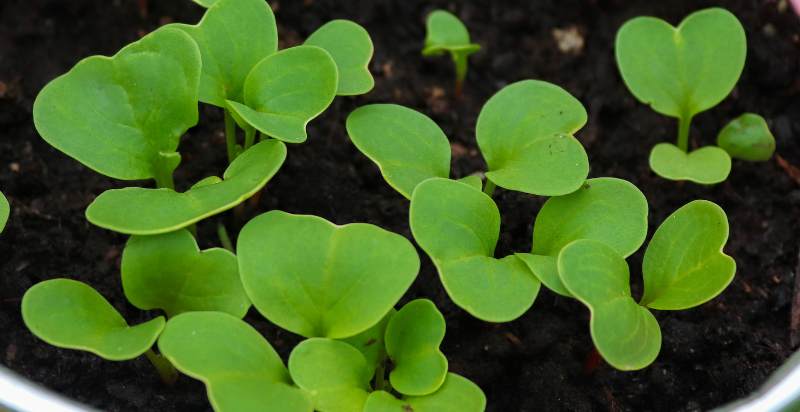
How to Care and Grow Radishes?
Radishes are a fast-growing crop and don’t require any special care beyond regular watering. While they prefer cooler weather, some varieties can tolerate warmer temperatures. Make sure to plant them early in the season so you can enjoy your harvest before it gets too hot outside.
Once the radishes start to grow, keep an eye out for pests such as aphids or slugs that may try to feed on the leaves or roots. Handpick them off, or use row covers to protect the plants from these pests. For diseases like root rot, plant them in well-draining soil and water deeply but less frequently during dry spells. Fertilize with aged compost every few weeks to give them a boost of nutrients.
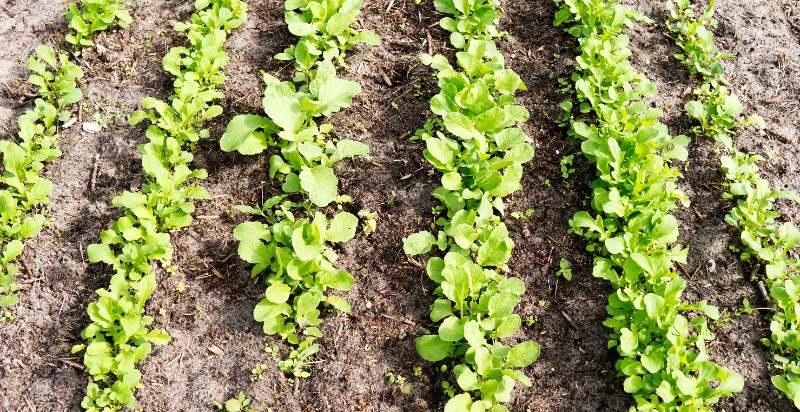
Preventions from Pests and Diseases:
Practicing good garden maintenance is the best way to prevent pests and diseases. This includes traditional weddings, keeping the soil healthy with plenty of organic matter, and rotating crops yearly. You can also use row covers to protect your radishes from common pests like aphids or slugs.
If you notice any signs of disease, remove affected plants immediately to reduce the risk of spreading them to other plants in your garden. Finally, ensure not to overcrowd your radishes as this will increase their risk of developing diseases.
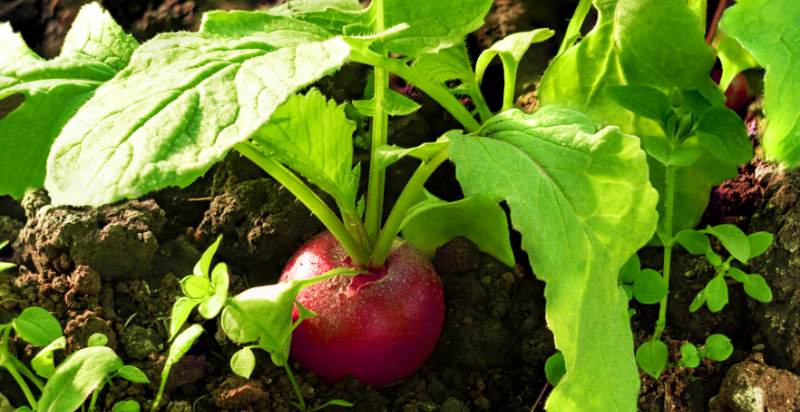
How to Harvest Radishes?
Harvesting radishes is an easy process that can be done with minimal effort. The best time to harvest your radish crop is when the tops of the plant are about two inches tall and the radish bulb is round and firm.
To begin harvesting, use a small garden spade or trowel to dig around the base of the radish. Gently loosen the soil and lift the entire clump out of the ground. You may need to cut through some roots to free up the plant.
Once you have removed your radishes, shake off any excess dirt and inspect each one for blemishes or signs of disease before storing them in a cool, dry place. To store in the refrigerator, wrap each radish individually in a damp paper towel and place them in an airtight container.
To prepare your radishes for eating, wash away any dirt or debris with cool water, then cut off the leaves and tops. Slice or dice as desired, and enjoy! Radishes can be eaten raw, cooked, or pickled for long-term storage.
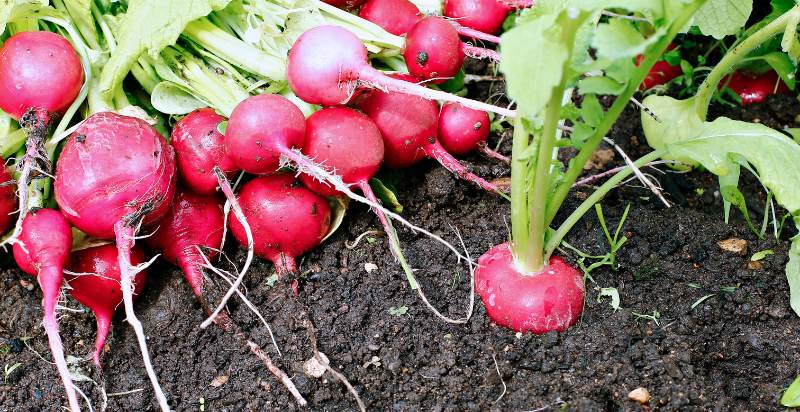
How to Store Homegrown Radishes?
Harvested radishes should be stored in a cool, dry place away from direct sunlight. You can also store them in the refrigerator if needed. To do this, wrap each radish in a damp paper towel and place them in an airtight container. Radishes will keep for up to two weeks when stored properly.
Pickling is a great option if you want to store your homegrown radishes for longer than two weeks. Pickled radishes will last several months in the refrigerator and are perfect for adding extra flavor to salads or sandwiches.
To pickle, cut washed and dried radishes into quarters or slices, then add them to a jar along with garlic cloves, red pepper flakes, and your favorite pickling spices. Fill the jar with a vinegar brine and let it sit in the refrigerator for at least three days before serving. For extra flavor, pickled radishes can be enjoyed or added to salads and other dishes.
Radishes are a tasty and nutritious addition to any home garden. With the right care, these versatile vegetables can provide you with a bounty of fresh produce all season long. So follow the tips to ensure that your radish crop will be plentiful and delicious!
How To Include Radishes In Your Diet?
Radishes can be included in various dishes and are a great way to add flavor and crunch to meals. They can be eaten raw, roasted, braised, pickled, or added to salads, sandwiches, soups, stews, stir-fries, and even pasta. Roasted radishes make an excellent side dish for cooked meats or fish. Pickling is also a great way to preserve the bright flavor of radishes for longer periods.
Radishes also make a delicious addition to juicing recipes when combined with other vegetables, such as carrots or cucumbers. Lastly, radish sprouts are another great way of incorporating radishes into your diet – they offer all of the nutritional benefits of the vegetable and make an attractive garnish for salads or sandwiches. Regardless of how you enjoy them, radishes are a tasty and nutritious addition to any meal!
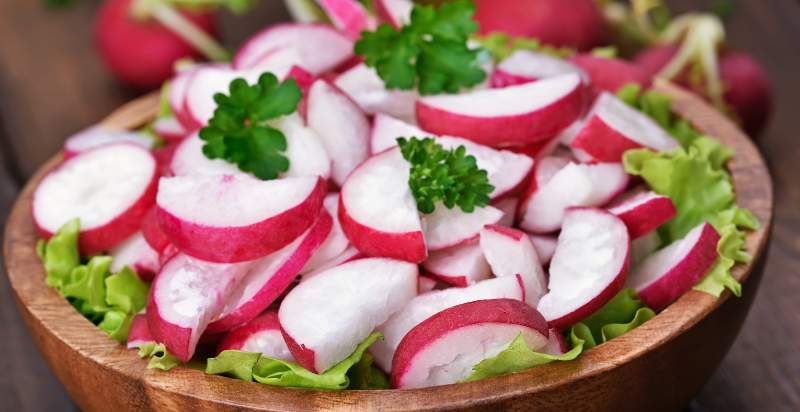
Potential Risks from Radishes:
Like most vegetables, radishes are generally healthy when consumed in moderation. However, people with kidney or gallbladder problems should avoid them as the high oxalate content could aggravate these conditions. Radishes also cause bloating and flatulence, particularly when eaten raw in larger amounts.
If you experience any adverse reactions from eating radishes, reduce your consumption or choose to cook them instead of eating them raw. Additionally, it is important to ensure that all radish varieties (wild and cultivated) purchased at a store have not been treated with pesticides or herbicides. Lastly, be aware that some individuals may be allergic or sensitive to radishes, so it’s best to introduce them into your diet slowly and cautiously if this applies to you.
Conclusion:
Radishes are nutritious and versatile vegetables that can be used in various dishes. They are an excellent source of dietary fiber, vitamins, minerals, and other important plant compounds. When eaten in moderation and prepared properly, radishes offer numerous health benefits.
However, people with existing conditions such as kidney or gallbladder disease should avoid consuming large amounts of radish to prevent exacerbating these issues. Additionally, those who may be sensitive or allergic to radishes should introduce them slowly into their diet. With the proper precautions, radishes can easily become part of your healthy eating plan!
- Everything You Wanted to Know About Red Tamarillos - June 2, 2025
- A Guide to Tulips: Everything You Need to Know & More… - June 2, 2025
- Guanabana: Description, Flavor, Benefits, And Uses - May 27, 2025

8 thoughts on “What is Radish? How to Plant, Grow, and Harvest Radish Root ”
Comments are closed.